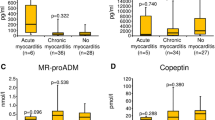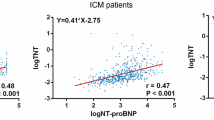Abstract
The mortality of patients with non-ischemic dilated cardiomyopathy (NIDCM) remains substantial. We evaluated gene expression levels of myocardin, an early cardiac gene, in the peripheral blood cells of NIDCM patients as a prognostic biomarker in their long-term outcome and mortality from congestive HF (CHF). We retrospectively analyzed 101 consecutives optimally treated NIDCM patients of Cretan origin who were enrolled from the HF clinic of our hospital from November 2005 to December 2008. Our patient data were either taken from their medical files or recorded during visits to the HF unit or hospitalizations. Follow-up was carried out by telephone interview and by accessing information from general practitioners and cardiologists in private practice. The median follow-up period was 8 years (mean follow-up 7 ± 3.4 years). The overall mortality during follow-up was 61.4%, while mortality due to congestive heart failure (CHF) was 49.5%. Higher CHF and all-cause mortality were observed in patients with myocardin levels < 14.26 (p < 0.001 for both CHF and all-cause mortality). A multivariate Cox regression analysis showed that myocardin level of expression had independent significant prognostic value for the risk of death from CHF (HR 14.5, 95% confidence interval (CI) 5.3–39) in those patients. Peripheral blood cells gene expression of myocardin, an early myocardial marker, may serve as prognostic biomarkers of the long-term outcome of patients with NIDCM. Our findings open new prospects in the risk stratification of these patients.


Similar content being viewed by others
References
Pinto YP, Elliott PM, Arbustini E, Adler Y, Anastasakis A, Bohm M, Duboc D, Gimeno J, de Groote P, Imazio M, Heymans S, Klingel K, Komajda M, Limonngelli G, Linhart A, Mogensen J, Moon J, Pieper PG, Seferovic PG, Schueler S, Zamorano JI, Caforio ALP, Charron P (2016) Proposal for a revised definition of dilated cardiomyopathy, hypokinetic non-dilated cardiomyopathy, and its implications for clinical practice: a position statement of the ESC working group on myocardial and pericardial diseases. Eur Heart J 37:1850–1858
Richardson P, McKenna W, Bristow M, Maisch B, Mautner B, O’ Connell J, Olsen E, Thiene G, Goodwin J, Gyarfas I, Martin I, Nordet P (1996) Report of the 1995 World Health Organization/International Society and Federation of Cardiology Task Force on the definition and classification of cardiomyopathies. Circulation 93:841–842
Japp AG, Gulati A, Cook SA, Cowie MR, Prasad SK (2016) The diagnosis and evaluation of dilated cardiomyopathy. J Am Coll Cardiol 67:2996–3010
Fuster V, Gersh BJ, Giuliani ER, Tajik AJ, Brandenburg RO, Frye R (1981) The natural history of idiopathic dilated cardiomyopathy. Am J Cardiol 47:525–531
Ponikowski P, Voors AA, Anker SD, Bueno H, Cleland JGF, Coats AJS, Falk V, González-Juanatey JR, Harjola VP, Jankowska EA, Jessup M, Linde C, Nihoyannopoulos P, Parissis JT, Pieske B, Riley JP, Rosano GMC, Ruilope LM, Ruschitzka F, Rutten FH, van der Meer P (2016) ESC guidelines for the diagnosis and treatment of acute and chronic heart failure: the task force for the diagnosis and treatment of acute and chronic heart failure of the European Society of Cardiology (ESC). Developed with the special contribution of the heart failure association (HFA) of the ESC. Eur Heart J 37:2129–2200
Mele D, Nardozza M, Ferrari R (2018) Left ventricular ejection fraction and heart failure: an indissoluble marriage? Eur J Heart Fail 20:427–430
Køber L, Thune JJ, Nielsen JC, Videbæk L, Korup E, Jensen G, Hildebrandt P, Steffensen FH, Bruun NE, Eiskjær H, Brandes A, Thøgersen AM, Gustafsson F, Egstrup K, Videbæk R, Hassager C, Svendsen JH, Høfsten DE, Torp-Pedersen C, Pehrson S (2016) DANISH investigators defibrillator implantation in patients with nonischemic systolic heart failure. N Engl J Med 375:1221–1230
Kitai T, Miyakoshi C, Morimoto C, Yaku H, Murai R, Kaji S, Furukawa Y, Inuzuka Y, Nagao K, Tamaki Y, Yamamoto E, Ozasa N, Tang WHW, Kato T, Kimura T (2020) Mode of death among Japanese adults with heart failure with preserved, midrange, and reduced ejection fraction. JAMA Netw Open 3:e204296
Schefer T, Wolber T, Binggeli C, Holzmeister J, BrunckHorst C, Duru F (2008) Long-term predictors of mortality in ICD patients with non-ischaemic cardiac disease: impact of renal function. Europace 10:1052–1059
Bruneau BG (2002) Transcriptional regulation of vertebrate cardiac morphogenesis. Circ Res 90:509–519
Torrado M, López E, Centeno A, Medrano C, Castro-Beiras A, Mikhailov A (2003) Myocardin mRNA is augmented in the failing myocardium: expression profiling in the porcine model and human dilated cardiomyopathy. J Mol Med (Berl) 81:566–577
Kontaraki JE, Parthenakis FI, Nyktari EG, Patrianakos AP, Vardas PE (2010) Myocardial gene expression alterations in peripheral blood mononuclear cells of patients with idiopathic dilated cardiomyopathy. Eur J Heart Fail 12:541–548
Kontaraki JE, Parthenakis FI, Patrianakos AP, Karalis IK, Vardas PE (2008) Myocardin gene regulatory variants as surrogate markers of cardiac hypertrophy-study in a genetically homogeneous population. Clin Genet 73:71–78
Oka T, Xu J, Molkentin JD (2007) Re-employment of developmental transcription factors in adult heart disease. Semin Cell Dev Biol 18:117–131
Rajabi M, Kassiotis C, Razeghi P, Taegtmeyer H (2007) Return to the fetal gene program protects the stressed heart: a strong hypothesis. Heart Fail Rev 12:331–343
Mikhailov AT, Torrado M (2012) In search of novel targets for heart disease: myocardin and myocardin-related transcriptional cofactors. Biochem Res Int 2013:973723
Aziz H, Zaas A, Ginsburg G (2007) Peripheral blood gene expression profiling for cardiovascular disease assessment. Genomic Med 1:105–112
Liew C-C, Ma J, Tang H-C, Zheng R, Dempsey AA (2006) The peripheral blood tran-scriptome dynamically reflects system wide biology: a potential diagnostic tool. J Lab Clin Med 147:126–132
Russo AM, Stainback RF, Bailey SR, Epstein AE, Heidenreich PA, Jessup M, Kapa S, Kremers MS, Lindsay BD, Stevenson LW (2013) ACCF/HRS/AHA/ASE/HFSA/ SCAI/SCCT/SCMR 2013 appropriate use criteria for implantable cardioverter-defibrillators and cardiac resynchronization therapy. J Am Coll Cardiol 61:1318–1368
Nagueh SF, Appleton CP, Gillebert TC, Marino PN, Oh JK, Smiseth OA, Waggoner AD, Flachskampf FA, Pellikka PA, Evangelista A (2009) Recommendations for the evaluation of left ventricular diastolic function by echocardiography. J Am Soc Echocardiogr 22:107–133
Matsumura Y, Takata J, Kitaoka H, Kubo T, Baba Y, Hoshikawa E, Hamada T, Okawa M, Hitomi N, Sato K, Yamasaki M, Yabe `T, Furuno T, Nishinaga M, Doi Y (2006) Long-term prognosis of dilated cardiomyopathy revisited: an improvement in survival over the past 20 years. Circ J 70:376–383
Fudim M, Kelly JP, Jones AD, AbouEzzeddine OF, Ambrosy AP, Greene SJ, Reddy YNV, Anstrom KJ, Alhanti B, Lewis GD, Hernandez AF, Felker GM (2020) Are existing and emerging biomarkers associated with cardiorespiratory fitness in patients with chronic heart failure? Am Heart J 220:97–107
Wettersten N, Horiuchi Y, van Veldhuisen DJ, Mueller C, Filippatos G, Nowak R, Hogan C, Kontos MC, Cannon CM, Müeller GA, Birkhahn R, Taub P, Vilke GM, Barnett O, McDonald K, Mahon N, Nuñez J, Briguori C, Passino C, Maisel A, Murray PT (2020) Short-term prognostic implications of serum and urine neutrophil gelatinase-associated lipocalin in acute heart failure: findings from the AKINESIS study. Eur J Heart Fail 22:251–263
Fernandez C, Rysä J, Ström K, Nilsson J, Engström G, Orho-Melander M, Ruskoaho H, Melander O (2020) Circulating protein biomarkers predict incident hypertensive heart failure independently of N-terminal pro-B-type natriuretic peptide levels. ESC Heart Fail 7:1891–1899
Maciejak A, Kiliszek M, Michalak M, Tulacz D, Opolski G, Matlak K, Dobrzycki S, Segiet A, Gora M, Burzynska B (2015) Gene expression profiling reveals potential prognostic biomarkers associated with the progression of heart failure. Genome Med 7:26
Stojkovic S, Koller L, Sulzgruber P, Hülsmann M, Huber K, Mayr M, Hengstenberg C, Wojta J, Niessner A (2020) Liver-specific microRNA-122 as prognostic biomarker in patients with chronic systolic heart failure. Int J Cardiol 303:80–85
Schulte C, Westermann D, Blankenberg S, Zeller T (2015) Diagnostic and prognostic value of circulating microRNAs in heart failure with preserved and reduced ejection fraction. World J Cardiol 7:843–860
Heidecker B, Kasper EK, Wittstein IS, Champion HC, Breton E, Russell SD, Kittleson MM, Baughman KL, Hare JM (2008) Transcriptomic biomarkers for individual risk assessment in new-onset heart failure. Circulation 118:238–246
Miano JM (2015) Myocardin in biology and disease. J Biomed Res 29:3–19
Whitcomb J, Gharibeh L, Nemer M (2020) From embryogenesis to adulthood: Critical role for GATA factors in heart development and function. IUBMB Life 72:53–67
Dirkx E, da Costa Martins PA, De Windt LJ (2013) Regulation of fetal gene expression in heart failure. Biochim Biophys Acta 1832:2414–2424
McNamara DM, Starling RC, Cooper LT, Boehmer JP, Mather PJ, Janosko KM, Gorcsan J 3rd, Kip KE, Dec GW, Investigators IMAC (2011) IMAC Investigators. Clinical and demographic predictors of outcomes in recent onset dilated cardiomyopathy: results of the IMAC-2 study. J Am Coll Cardiol 58:1112–1118
Funding
No financial support was received for this study and there are no conflicts of interest by any of the authors.
Author information
Authors and Affiliations
Corresponding author
Ethics declarations
Conflict of interest
None to declare.
Additional information
Publisher's Note
Springer Nature remains neutral with regard to jurisdictional claims in published maps and institutional affiliations.
Rights and permissions
About this article
Cite this article
Marketou, M.E., Kontaraki, J., Patrianakos, A. et al. Long-term prognostic value of myocardin expression levels in non-ischemic dilated cardiomyopathy. Heart Vessels 36, 1841–1847 (2021). https://doi.org/10.1007/s00380-021-01869-0
Received:
Accepted:
Published:
Issue Date:
DOI: https://doi.org/10.1007/s00380-021-01869-0




